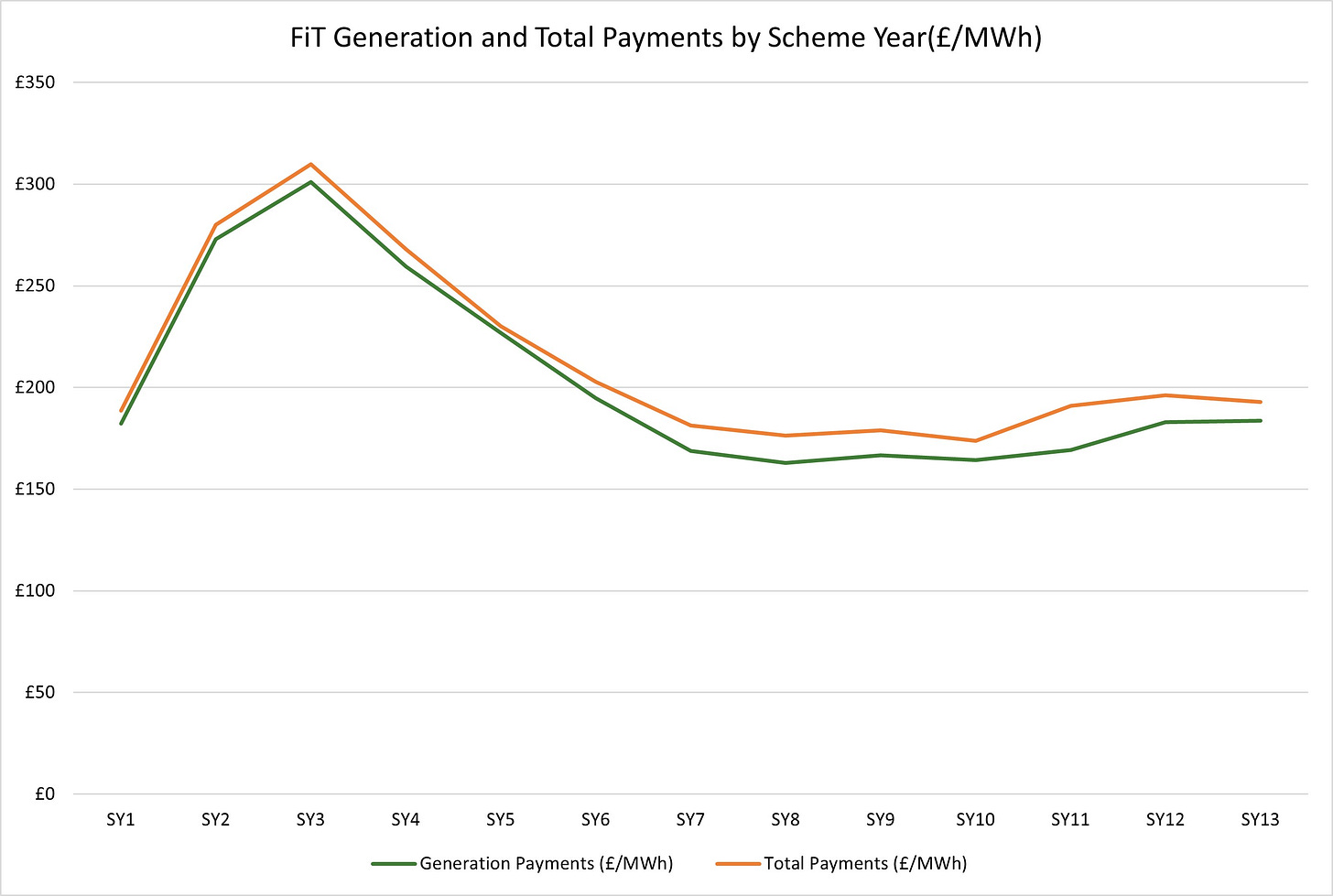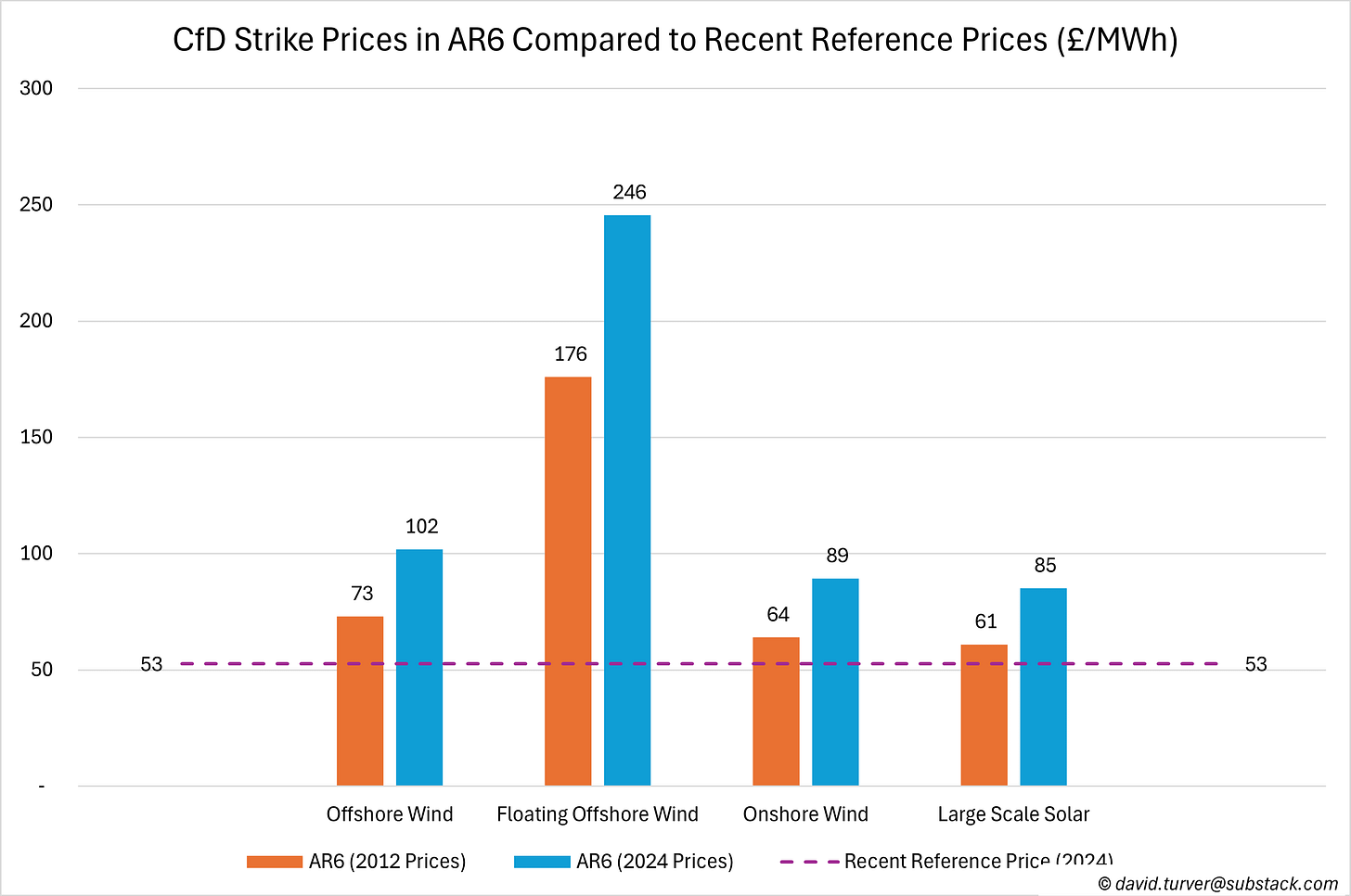Debunking the Cheap Renewables Myth
We keep getting told that wind and solar renewables are cheap, yet our bills keep going up. So, what's going on?
Last week, I decided to write a Twitter/X post to summarise how much we are paying for renewables. It got far more traction than I anticipated, so I thought it would be helpful to convert it and extend it a little to make a bonus article on Substack that can act as a succinct response to all those who still insist on claiming renewables are cheap.
In the UK, renewables are subsidised by three different schemes. Feed-in-Tariffs (FiTs) fund mostly solar power. The latest report for 2022-23 shows the scheme cost over £1.7bn and average total payment was ~£193/MWh, about 3X the current cost of gas-fired power at around £65/MWh (see Figure A).
Contracts for Difference (CfDs) fund a range of technologies, but most of the subsidy goes to offshore wind. Latest data from the LCCC shows the subsidy per MWh fell dramatically during the energy crisis, but is now back at £95/MWh for offshore wind, £73/MWh onshore and £60/MWh for solar. April 2024 was a record month for overall subsidies with £268m paid out with average strike prices at £146/MWh for offshore wind, £113/MWh for onshore and £110/MWh for solar power (See Figure B).
The CfD subsidy for burning trees in biomass plants rose from about £7/MWh in March to nearly £60/MWh in April. This encouraged more biomass generation and the total subsidy paid for biomass jumped from £2m in March to over £34m in April 2024. The total CfD subsidy paid for the last 12 months is over £2bn, and the trend is clearly upwards.
By far the biggest subsidy scheme is Renewables Obligations Certificates, costing over £7bn per year. This scheme awards certificates for each MWh generated, a different number depending upon technology. April reference prices for intermittent renewables have been around £53/MWh, meaning the average price paid for offshore wind under the ROC scheme has been £176/MWh, onshore £118/MWh and solar £146/MWh including the value of the certificates (See Figure C).
Future renewables are also going to be more expensive than current market rates. The Government’s announcements of prices for their Allocation Rounds are often quoted in 2012 money. In 2024 money, Allocation Round 6 (AR6) is offering £102/MWh for fixed offshore wind, £246/MWh for floating offshore wind, £89/MWh for onshore and £85/MWh for solar power, all far higher than current market prices (see Figure D).
It should be noted that FiTs, ROCs and CfDs are all index-linked, so prices will continue to rise with inflation. It is clear our bills are going to continue to rise for the foreseeable future as cheap gas is forced out in favour of expensive renewables.
In addition, we pay extra for balancing the grid when the wind is not blowing (or blowing too hard) and the sun is not shining. In the year ending March 2024, these balancing services cost £2.46bn. Most of these costs should be attributed as a cost of intermittent renewables. That's a total of over £12bn being paid to or because of renewables each year.
More costs are coming down the line as the National Grid ESO has announced £54bn of spending on the electricity network infrastructure up to 2030 and a further £58bn in the 2030-2035 period, a total of £112bn, or over £10bn per year for more than a decade.
I hope it is clear to all now that renewables are not cheap and are never going to be.
If you enjoyed this article, then please share it with your family, friends and colleagues and sign up to receive more content.






Sadly the data won't be enough to deter many of the Catastrophisers nor many of the public. I think the public will begrudgingly carry on scraping by. I think the defining moment will be when the grid collapses. Even then it will be blamed on fossil fuels, but I think the public will wake up at that point. Until then it's just accept a decline in living standards, as energy is priced into absolutely everything. Anyone noticed how expensive ANYTHING is these days?
So 12bn a year subsidy, for assets that have life span of about 25 years, where new nuclear would last 40 years plus, and a coal or gas station can last 50 years.
112bn of extra hideous pylons on top of that, and of course, with more lines comes more maintenance costs and more linesmen.
And then we haven't even started on the cost of any hydrogen back up for seasonal renewables failures or the cost of grid batteries.
I did a simple sum the other day, that if we had peak demand of 135-150GW in the winter, in a blocking high where the average daily demand was 90GW per day average, and the blocking high lasted 4 weeks would require, at the cheapest price for grid batteries I could find of £120/kwh capacity, would cost 6.4 TRILLION in battery installations to supply it.
Q when is this madness of renewables going to end?
Fact is, energy is the basis of a competitive economy, this is going to completely sink our economy, fact is, you won't be able to afford to live at these prices